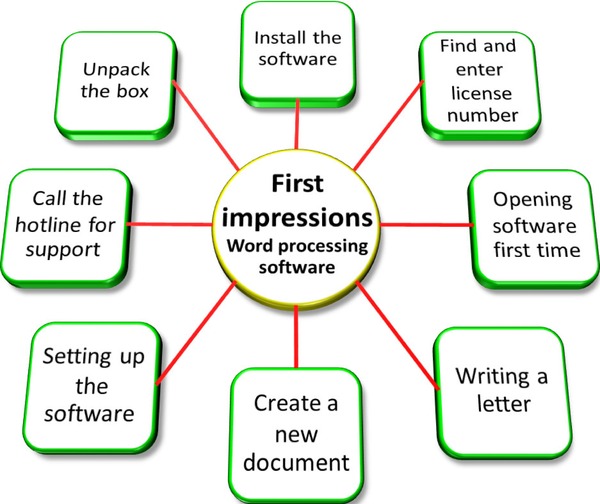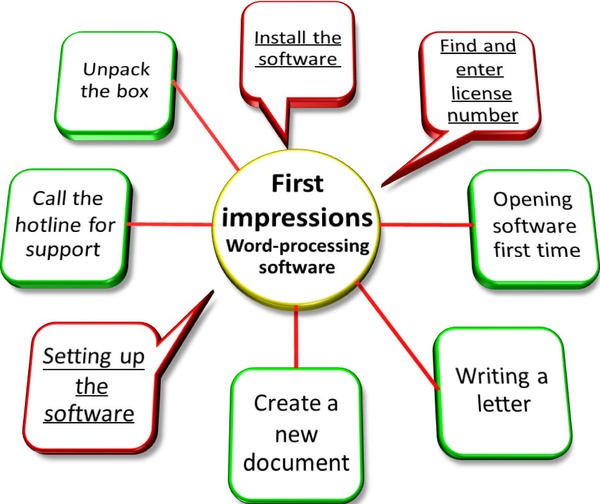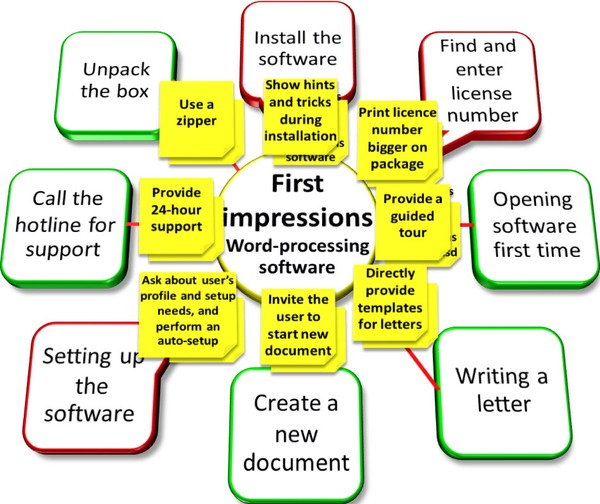Method for Innovating Around First Impressions
The following sections will describe a concrete and straightforward approach to creating potentially successful user experience innovation around first impressions. In overview, the method consists of four steps:
- Identify core tasks of your first impressions.
- Identify pain points in your first impressions.
- Innovate solutions.
- Document results and process the output.
Throughout this chapter, I will use as an example a piece of word-processing software. I will assume that this software is sold as a DVD in a shop.
Step 1: Identify Core First Impression Tasks
The first thing you want is to identify the key elements that are part of the first impression of your product. You basically want to identify which core tasks the user needs to go through to get started using your product. I choose to define these as core tasks even though the user may only need to perform these tasks once (depending on your product). These tasks are core tasks since if the user does not succeed in performing them, then you will most likely already have lost a customer.
For a device you will hence list things like the packaging, the out-of-the-box experience, battery insertion and charging, and the experience when the product is first switched on. You will also need to look at the interaction of parts when the user first starts using your product as intended.
For a website you will list elements like the start screen, login functionality, initial Flash animations, basic layout, and navigation of your screen, as well as how the user gets to and executes the core tasks. For a piece of software, you will need to list download experience, or out-of-the-box experience if sold on CD/DVD. You also want to list the installation process, which is very often a hurdle for many users, and you want to consider the start-up time of your software and the first interactions the user needs to go through to start a core task.
The method for finding the core tasks around your first impressions is basically the same as that that described in Chapter 6. In this case, though, you will look solely to tasks that users need to go through the first time they unwrap and use the product.
Figure 10-5 shows a list of first impression elements for the example of the word-processing software.

Figure 10-5. Example of first impression core tasks for a specific word-processing software package
Step 2: Identify First Impression Pain Points
The next step is to identify which of the core tasks of your first impression includes pain points. You can use the same method as described in Chapter 9, but apply the method specifically to your first impression tasks.
You will want to identify in detail what each pain point is about (in the example in Figure 10-6 I have marked the problematic areas by underlining them).

Figure 10-6. Identifying pain points in your first impression (marked in underline)
Step 3: Innovate Solutions
You now have the basis for innovating around the user’s first-time experience. Again, you will want to gather a group of cross-functional team members and ideally some end users. Begin by reviewing your drawing (such as the one in Figure 10-6), or whatever other list of first impressions you have identified.
You may want to start with the pain points, but you may also likely find great user experience innovation around the core tasks. Figure 10-7 shows an example of the outcome of the innovation workshop around the core tasks and pain points for the first-time experience.

Figure 10-7. Example of result of innovation around first impression
Step 4: Document the Results and Process the Output
How you choose to document your results is up to you, but you will need to list all ideas and then verify them with target users. You may, for example, prototype them initially in simple ways and present them to target or lead users. Chapter 18 goes into detail about prototyping and verification.
